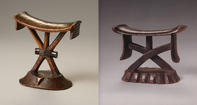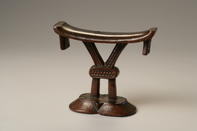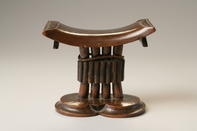Culture: Left: Shona; Right: Tsonga Period: 19th century Material: wood Left: H 14 cm, L 12.25 cm Right: H 13.5 cm, L 18.5 cm Many Shona and Tsonga headrests use a cross-shape in their supports, but some Tsonga carvers produced exceptionally fine, innovative examples in this tradition.

Evidence of this remarkable feel for form can be seen in the way the two diagonal cross elements of the support meet the pendants of the platform, not the platform itself. Details like these attest to the value some Tsonga-speaking communities placed on aesthetic excellence.
While there are a number of known examples of headrests with very similar in design to the Shona example on the right, no two are ever the same, each having its own individually distinguishing features. On this example, it might be the combination of the support and pendants, or the very protuberant 'V' shape at the centre of the platform side.

Culture: probably Shona Period: 19th century Material: wood Height: 14 cm, Length: 16.25 cm In the nineteenth century, inter-ethnic contact in south-eastern Zimbabwe, northern South Africa and southern Mozambique ensured that carvers from different ethnic groups came into contact with each others' styles.
Many migrants from Mozambique into Zimbabwe, the Transvaal and Natal are known to have carved objects for the people among whom they settled. The decorative motifs on the surface of the support of this headrest suggest a Shona origin, but it includes hybrid combinations of elements of both Shona and Tsonga headrest design.
The lobed and chamfered base with its central triangular notch, and the 'V' shape and central oval of the support, are derived from Shona forms, while the platform's shape and the pendants are more in line with Tsonga forms.

Culture: Shona/Tsonga Period: 19th century Material: wood Height: 18.5 cm, Length: 17 cm This headrest is similar to a number of documented and well-provenanced examples in European and Southern African museum collections: one was collected by Theodore Bent among the Shona in Zimbabwe, and another by William Distant among the Gwamba Tsonga in the Transvaal, both prior to 1892.
The artist who produced this headrest carved the outer columns so that they curve slightly inwards towards the centre, thereby animating the geometric form. Details like these are common in examples made by specialist carvers. The rope attached to this headrest would have been used by the owner to transport the headrest.

Culture: Shona Period: 19th century Material: wood Left: H 14 cm, Length: 16.75 cm Right: H 13 cm, L 15 cm Because 'Shona' is a super-ethnic category created by colonial powers to combine a number of sub-groups, it is not really possible to ascribe different headrest supports within this canonical design category to smaller ethnic entities.
Headrests like these use the familiar Shona iconography of female bodies and scarification, but the form of a human body is evoked more strongly in examples in which the triangle and circle motifs arc used to form vertical support units.
By Professor Sandra Klopper